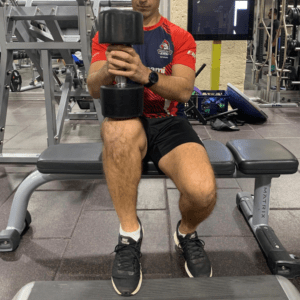In Part One of this blog series, we explored how to structure a weight training program to improve performance and prevent injury. Parts Two and Three of this blog series will explore what specific exercises a runner should be doing.
The aim should be to complete two sessions per week with 3 sets of 8 to 12 reps, ensuring that the final couple of reps are challenging. The tempo should be slow and controlled, with 2 to 3 minutes between each set. Here is a list of the recommended exercises:
Standing calf raise:
There are a number of variations, including machine based, barbell and dumbbell calf raises. We will explore the technique for dumbbell standing one-leg calf raises.
- Stand on a step with the balls of your feet, with the heels extending off it.
- Keeping your torso upright and holding onto a dumbbell with the other hand providing support.
- Initiate the movement by contracting the calf and raising the heel as high as possible and hold the top position for a second.
- Gradually lower the heel as low as possible and hold the bottom position for one second.
There are a number of variations including machine based, barbell and dumbbell calf raises. We will explore the technique for dumbbell seated one-leg calf raises.
- Place a block or step on the floor about 12 inches from a flat bench.
- Sit on a flat bench and place a dumbbell on your upper left thigh above your knee.
- Place the ball of the foot on the block or step.
- Initiate the movement by contracting the calf and raising the heel as high as possible and hold the top position for a second.
- Gradually lower the heel as low as possible and hold the bottom position for one second.
 In Part Three of this blog series, we will discuss the correct technique for the remaining four exercises.
In Part Three of this blog series, we will discuss the correct technique for the remaining four exercises.
At Bend + Mend in Sydney’s CBD we perform comprehensive Running Assessments for people who want to improve their running speed and efficiency. Book in for an Assesssment at our Barangaroo clinic today.






